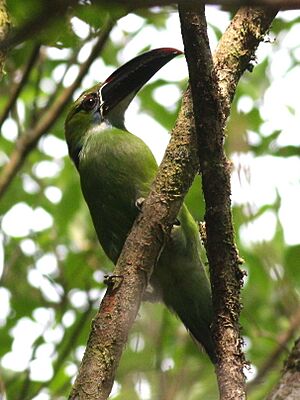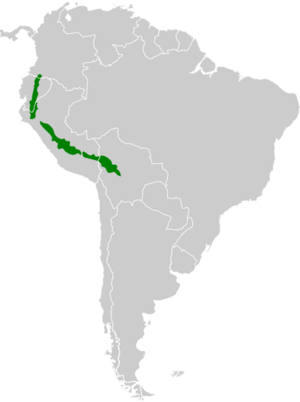Chestnut-tipped toucanet facts for kids
Quick facts for kids Chestnut-tipped toucanet |
|
|---|---|
 |
|
| Conservation status | |
| Scientific classification | |
| Genus: |
Aulacorhynchus
|
| Species: |
derbianus
|
 |
|
The chestnut-tipped toucanet (scientific name: Aulacorhynchus derbianus) is a colorful bird. It belongs to the toucan family, known as Ramphastidae. You can find this bird in South American countries like Bolivia, Colombia, Ecuador, and Peru.
Contents
What is a Chestnut-tipped Toucanet?
Its Family Tree
The chestnut-tipped toucanet is a unique bird. It is the only type of its species. For a while, people thought it was the same as the tepui toucanet. But scientists decided they were different species in 2011. This toucanet is also closely related to the groove-billed toucanet. They are part of a special group called a superspecies.
What Does It Look Like?
The chestnut-tipped toucanet is a medium-sized bird. It is about 33 to 41 centimeters (13 to 16 inches) long. It weighs between 141 and 262 grams (5 to 9 ounces).
Colors and Markings
This bird has a bright bill. It is mostly deep red and black. There is a white line at the bottom of its bill. Some birds might have an all-black bill. Both male and female toucanets look the same. Their bodies are mostly green. They have a bluish color on the back of their neck. Their throat is white. The tips of their tail feathers are a wide chestnut color. Their eyes are reddish-brown with some blue below them.
Where Does It Live?
Its Home in the Andes
The chestnut-tipped toucanet lives along the eastern side of the Andes Mountains. This mountain range stretches from southern Colombia through Ecuador and Peru. It goes as far as western Bolivia.
Preferred Habitat
These birds mostly live in subtropical montane cloudforest. This is a type of forest high up in the mountains. It often has clouds or fog. They also live in tropical forests in Bolivia. You can usually find them at elevations between 600 and 2,000 meters (2,000 to 6,600 feet) above sea level.
How Does It Behave?
Staying in One Place
Scientists believe the chestnut-tipped toucanet does not migrate. This means it stays in the same area all year round.
What It Eats
This toucanet usually looks for food in the top parts of trees. It often forages in pairs. Sometimes, you might see groups of up to 10 birds feeding together. Their main diet seems to be fruits and their seeds. They also eat some insects.
Raising Young
The breeding season for the chestnut-tipped toucanet is from May to October. Not much else is known about how they raise their young.
Its Calls
The song of the chestnut-tipped toucanet is a long series of notes. It sounds like "grrrrump" to "kwuk." Pairs often sing these notes together. They also make other sounds. These include "ggg-rgg," "ngg-ngg," and rattling "bbdt-bbdt" notes.
Is It Endangered?
The IUCN (International Union for Conservation of Nature) checks on animals. They have listed the chestnut-tipped toucanet as "Least Concern." This means it is not currently in danger of extinction. It lives in a large area. However, its total population size is not known. Scientists think its numbers might be going down. There are no immediate threats that have been found. It is common in some small areas. But overall, it is uncommon to rare in Ecuador and rare in Peru.


